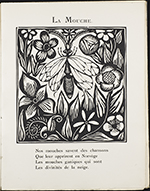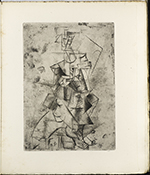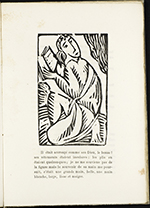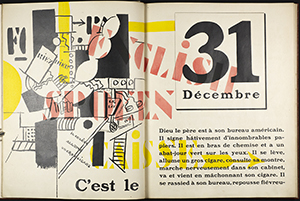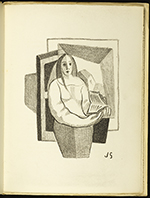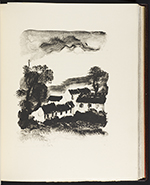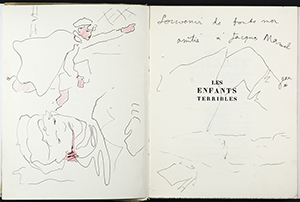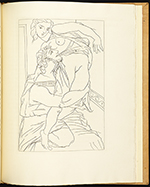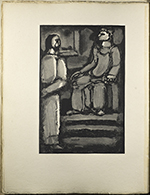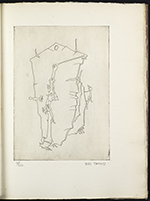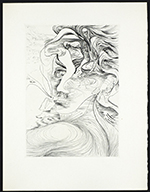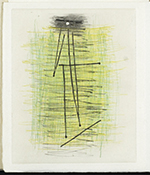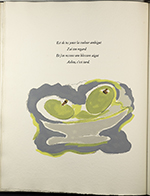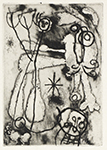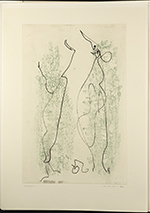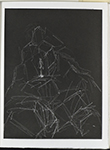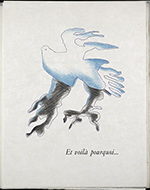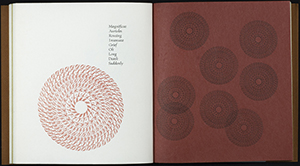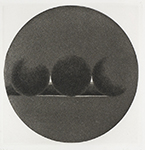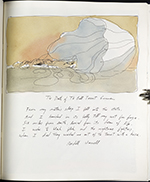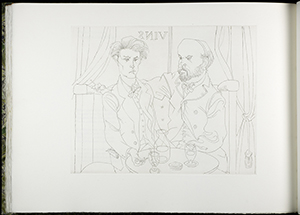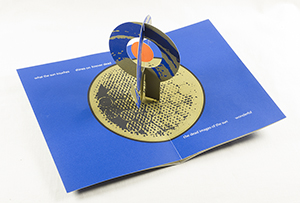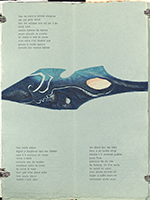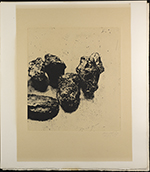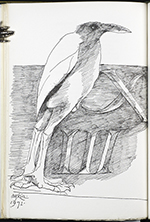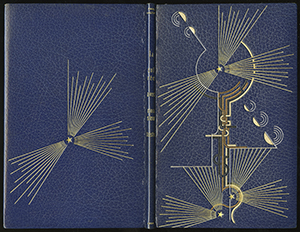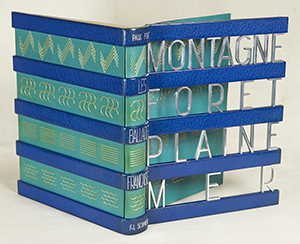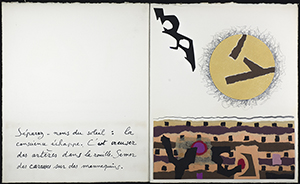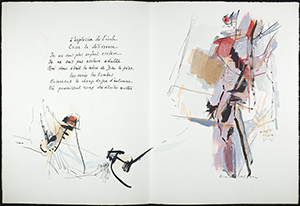Beyond Illustration: The Livre D'Artiste in the Twentieth
Century
An Exhibition
An Exhibition Compiled and Described by Breon
Mitchell
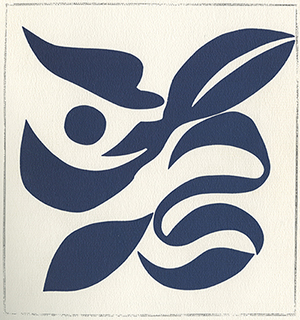
Cover: After a Georges Braque lithograph illustration
for Apollinaire's Si je moriais là-bas.
CONTENTS
- Foreword 5
- Acknowledgements 7
- Key to References 8
- Four Precursors to the Modern Livre
d'Artiste
9
- Pioneers of the Livre d'Artiste: 1910-1919
11
- The Livre d'Artiste Comes of Age: 1920-1950
18
- Tradition and Innovation: 1950-1970 34
- Recent Trends in the Livre d'Artiste:
1970-1975 54
- The Art of Binding 67
- Le Livre Unique
72
- Index 77
FOREWORD
Illustration has often been considered the stepchild of literature, a second-rate
art form which at best lamely retells a story in pictures. But along with the
more immediately apparent twentieth-century revolutions in the plastic arts,
music, and literature, a quiet but equally profound alteration has taken place
in the world of illustrated books. The result has been the appearance of a new
artistic genre, the livre d'artiste. The present
exhibition is an attempt to introduce this significant intersection of art and
literature to a wider audience. The one hundred books selected for display have
rarely been seen in the United States, and ten books in the exhibit are unique
copies which are shown here for the first time. Beginning with four monumental
precursors of the modern livre d'artiste, the
exhibit offers a brief visual history of the artist and the book in this
century, including many works which have already achieved the status of classics
of the genre. To these is added a broad cross-section of more recent
collaborations, including contemporary English and American productions. Modern
examples of book binding, as well as recent experiments in creating
"book-objects", are displayed; and the exhibition closes with the spontaneous
dialogues between author and artist which have found expression in the series
Le Livre Unique.
The livre d'artiste differs from the traditional
illustrated book in several respects. The illustrations are, in each case,
original works of art (woodcuts, lithographs, etchings, engravings) executed by
the artist himself and printed under his supervision. The book thus contains
original graphics of the kind which find their place on museum walls. Since the
employment of these autographic techniques limits the number of copies which can
be produced while maintaining the quality of impression, such books are usually
published in editions of less than three hundred copies, numbered and signed by
the artist. The livre d'artiste is also defined by
the stature of the artist. Virtually every major painter and sculptor of the
twentieth century— Picasso, Braque,
Ernst, Matisse, Kokoschka, Barlach, Miró, to name a few—has collaborated in the creation of
one or more such works. In many cases, book illustration has occupied such an
important place in the total oeuvre of the artist that no student of art history
can safely ignore it. Yet the study of the livre
d'artiste offers serious methodological problems.
In the last century, it is safe to say that the text traditionally outweighed its
illustration; today the livre d'artiste may
present us with art of such overwhelming power that the text is relegated to the
status of the libretto in an opera. Nevertheless, and even in the most
imbalanced cases, the art work can no longer be satisfactorily assessed outside
the total context of the book. Moreover a wide range of clearly significant
relationships between text and image does exist, including poetry written to
"illustrate" a series of graphics (Éluard's
Bestiaire for the etchings of Chastel is a case in point), or
true collaborations in which text and art arose in a give and take between
author and artist (as in the Livre Unique series
included in this exhibition). The livre d'artiste
is also the preferred genre of those artist/authors blessed with Doppelbegabung.
In all such cases, although perhaps to a lesser extent where such doubly talented
individuals as Kokoschka, Barlach, and Cocteau are concerned, it is no exaggeration to say that scholars
have barely scratched the surface of the subject. The livre d'artiste has long been the academic property
of the art historian, who has the training and knowledge necessary to analyze
the artist's work appropriately in its broader context. But its literary
component is rarely touched, let alone discussed meaningfully in relation to the
artist's work. At times, of course, it is unreasonable to expect word and image
to be mutually illuminating. Our scholarly understanding of Aristophanes is unlikely ever to be enhanced by
Picasso's
illustrations for Lysistrata, in spite of whatever intuitive
insights the artist may provide us. There are scores of counter-examples in the
twentieth century, however, which still await our scrutiny.
In part, the very revolution which freed art from the task of representation and
allowed the livre d'artiste to move beyond
illustration led directly to our dilemma. Illustration, traditionally, was
successful when it convinced the reader that this was indeed the hero's face,
the countryside through which he moved, the house in which he lived. Hence the
phrase "abstract illustration" may still strike us as an oxymoron. We have yet
to develop a sensitive vocabulary for describing the relationship between word
and image, let alone a satisfactory methodology for analyzing it.
Even as we attempt to come to grips with this central issue, the art of the book
is developing in new directions of even greater complexity. In this exhibition,
it is possible to touch only briefly upon the equally revolutionary development
in twentieth-century binding. Today, through the efforts of such pioneers as
Pierre Legrain,
Paul Bonet, and Edgar Mansfield, fine
binding has achieved the status of an expressive art form in its own right. This
fact may be responsible in part for the rediscovery, in the last decade, of the
book as a physical object, capable of being transformed into three-dimensional
sculpture, the livre objet. Two recent
bibliographies of this most recent genre in the world of books include a
combined total of over five hundred entries. Yet, even in comparison with the
livre d'artiste, the livre
objet exists, as yet, in almost total obscurity.
A final, if mundane, difficulty confronts the scholar interested in the livre d'artiste. Access to the works is difficult,
particularly in the United States, and especially for works published in the
last fifteen years. Art museums hesitate to purchase "books," and few libraries
can afford to acquire art. Only in rare instances, such as the cooperative
efforts of the Indiana Museum of Art and the Lilly Library, do we find
exceptions to this rule. Well over half of the books displayed in this
exhibition have been published since 1960, yet another
proof, if one were needed, that libraries are alive and often surprisingly ahead
of their time.
—Breon Mitchell
ACKNOWLEDGEMENTS
In preparing this exhibition, I am deeply indebted to the work of others, and in
particular to Philip
Hofer and Eleanor M.
Garvey's The Artist and the Book: 1860-1960, which has
become the standard reference work in the field. W.J. Strachan's
The Artist and the Book in France also provides a helpful and
detailed narrative of the livre d'artiste in that
country. Both works include extensive bibliographies on the subject, and the
interested reader should turn to them for further information. Several people
have cooperated in insuring that this exhibition became a reality, and I would
like to thank the following: Thomas Solley, Director
of the Indiana University Museum of Art; Jan
Driesbach, Researcher at the Museum; Mary
Schreiter of the Lilly Library; Thomas
Coleman of the Department of Fine Arts; and Ulrich Weisstein of the Comparative Literature Program.
Photographic work for this catalogue was done by Tom
Casella of the Indiana University Photographic Services; I am
thankful for the careful attention he gave to our particular needs.
I also owe special thanks to William Cagle, Acting
Director of the Lilly Library, both for his encouragement in this project, and
for the vision with which he has moved to build the Lilly's special collections
in this field. His detailed knowledge of the livre
d'artiste and his intimate acquaintance with the collection were
invaluable factors in mounting the exhibition.
Finally I would like to thank Jean Kamerman of the
Lilly Library, who assisted me in all facets of planning and developing the
exhibition. Her untiring energy and resourcefulness, both in attending to points
of detail and in the considerable physical labor involved in mounting the
exhibition, were important factors in the realization of the project. Her advice
and suggestions in all matters touching upon the exhibition were deeply
appreciated.
KEY TO REFERENCES
The books listed in this catalogue are arranged, for the most part, in
chronological order. Unless otherwise indicated, the dimensions given refer to
the page size, with height preceding width. I am particularly indebted to the
following works in describing many of the items in this exhibition:
- AB The Artist and the Book: 1860-1960 in Western Europe and the
United States. Introduction by Philip Hofer, catalogue by Eleanor M. Garvey. Boston:
Museum of Fine Arts, [1961].
- ABF The Artist and the Book in France, by W.J.
Strachan. London: Peter Owen, [1969].
- AF The Arts of the French Book—1900-1965: Illustrated Books
of the School of Paris, by Eleanor M. Garvey and Peter W. Wick. Dallas: Southern Methodist
University Press, 1967.
- K 50 Ans d'édition de D.-H. Kahnweiler. Introduction
and catalogue by Jean Hughes. [Paris]: Galerie
Louise Leiris, 1969.
- PC La Poésie contemporaine de langue française depuis
1945, by Serge
Brindeau and others. [Paris]: Éditions
Saint-Germain-des-Prés, [1973].
- PS Anthologie du livre illustré par les peintres et
sculpteurs de l'école de Paris. Introduction by Claude
Roger-Marx, essay by Henri Matisse, and catalogue by
Albert Skira. Geneva:
Éditions Albert Skira, [1946].
- TCB The Twentieth Century Book: Its Illustration and
Design, by John
Lewis. London: Studio Vista Limited, 1967.
Where the work cited includes a catalogue, reference is to the catalogue number
of the item under discussion. In all other cases reference is to page
number.
Four Precursors to the Modern Livre
d'Artiste
1.
Edward Young:
The Complaint, and the Consolation: or Night
Thoughts. London: R. Noble and
R. Edwards, 1797.
With
forty-three original engravings by Blake. Size: 42.4 x 32.5
cm.
Lilly Library call number:
PR 3782 .C5 1797 vault
William
Blake's books of poetry with his own original hand-colored
illustrations sold so poorly upon their appearance that in more than one
case only a single copy has survived. His decision to illustrate Young's
Night Thoughts was no doubt partly motivated by the
thought that the very popular text would bring his own work to the
attention of a wider circle of readers. Like later pioneering efforts to
unite the artist and the book, Night Thoughts too was a
commercial disaster, and the three parts which were to follow never
appeared. Nevertheless William Blake remains a
touchstone of the development of the livre
d'artiste in this century, and his work presents a level
of achievement to challenge the greatest artists of our time.
2.
Goethe:
Faust. Translated by Albert
Stapfer. Paris:
Motte, 1828.
With eighteen original lithographs (including a portrait of
Goethe) by Delacroix. Size:
42.8 x 28.5 cm. Ref: AF 1.
Lilly Library call number:
PT2029 .F4 F27 vault
It may be said that modern book illustration begins with this edition of
Goethe's Faust, accompanied by eighteen
original lithographs by Delacroix. The fact
that Delacroix was moved to do these illustrations by a
production of Faust he attended in London in 1825 serves only to underline the international
crosscurrents which resulted in this classic of Romantic book
illustration. Goethe's oft
quoted reaction to Delacroix's
interpretation deserves repetition here: "And if I must confess that
M.
Delacroix has, in some scenes, surpassed my own notions, how
much more will the reader find all in full life, and surpassing his
imagination." Almost fifty years were to pass before a work of
comparable magnitude was attempted again: Manet's lithographs for the
French translation of The Raven.
3.
Edgar Allan
Poe:
Le Corbeau, The Raven. Translated by
Stéphane Mallarmé. Paris:
Richard
Lesclide, 1875.
With four original lithographs by Manet. One of 240 copies,
signed by the artist and author. Size: 54.5 x 35.9 cm. Ref: AB 178,
AF 2, PS 220.
Lilly Library call number:
PS2609 .A45 1875 vault
Manet and
Mallarmé were close friends, and their collaboration on
this French edition of Poe's The
Raven is a masterpiece of nineteenth-century book
production. Published in 1875, it was fully
twenty-five years ahead of its time in concept and design. As Eleanor Garvey has
pointed out, the "bold simplifications, diagonal compositions, and
opposition of tones [in Manet's lithographs] recall
his interest in Japanese prints." One lithograph in particular, of an
empty chair, with the shadow of the raven cast upon the
floor, is amazingly modern and abstract. One has only to think how Doré,
Manet's
contemporary, might have illustrated The Raven to
appreciate the distance which separates these lithographs from
traditional illustration of the time. Le Corbeau was a
commercial failure in spite of its low price, and the daring venture was
not repeated by the publisher. Nevertheless the book remains one of a
handful of truly distinguished forerunners of the modern livre d'artiste. The historical nexus of
literary and artistic relationships (Manet/ Mallarmée/
Poe)
lends it a unique interest for scholars concerned with comparative and
interdisciplinary studies.
4.
Geoffrey
Chaucer:
The Works of Geoffrey Chaucer Now Newly
Imprinted.
Hammersmith [London]: Kelmscott
Press, 1896.
With
eighty-seven original wood engravings designed by Burne-Jones and original wood engraved ornamental
borders and initials by Morris. One of the 425
paper copies (with thirteen on vellum). Size: 42.5 x 29.2 cm. Ref:
AB 45.
Lilly Library call number:
PR1105 .K340 vault
William
Morris and the Kelmscott Press stand at the beginning of the
development of modern twentieth-century printing. The importance of this
monumental edition of Chaucer rests in the total
integration of text, typography, and illustration. Morris personally supervised
every detail of the book's production, including the wood engravings by
Burne-Jones, and the ornamental borders and initial letters
which Morris
cut himself. He always aimed at perfection and sought the best materials
available for each book. Although he himself was a medievalist, the
works produced at his press profoundly influenced the direction of
modern book design in this century both in England and Germany.
PIONEERS OF THE LIVRE D'ARTISTE:
1910-1919
5.
Guillaume
Apollinaire:
Le Bestiaire ou Cortège
d'Orphée. Paris:
Deplanche, 1911.
With thirty-four original woodcuts by Dufy. One of ninety-one
copies on Hollande of a total edition of 120 copies, signed by the
artist and author. Size: 33.2 x 25.4 cm. Ref: AB 91, ABF 48, AF 9,
PS 99.
Lilly Library call number:
PQ2601 .P6 B56 vault
6.
Max Jacob:
Saint Matorel. Paris:
Henry Kahnweiler, 1911.
With four original etchings by Picasso.
One of ninety-one copies on Hollande van Gelder of a total edition
of 106 copies, signed by the artist and author. Size: 26.7 x 22.5
cm. Ref: AB 222, ABF 46, AF 10, PS 288.
Lilly Library call number:
PQ2619 .A17 S14 vault
7.
Max Jacob :
Les Oeuvres burlesques et mystiques de Frère Matorel
mort au couvent. Paris:
Henry Kahnweiler, 1912.
With sixty-six original woodcuts (some repeated)
by Derain. One of ninety-one copies on Hollande van Gelder
of a total edition of 106 copies, signed by the artist and author.
Size: 22.5 x 16 cm. Ref: AB 79, ABF 49, PS 81.
Lilly Library call number:
PQ2619 .A17 O28 vault
8.
Wassily
Kandinsky:
Klänge.
Munich: R. Piper &
Co., [1912].
With
thirty-six original woodcuts (twelve in color) by Kandinsky. One of 300 copies on Hollande van Gelder,
signed by the artist. Size: 27.9 x 27.9 cm. Ref: AB 138.
Lilly Library call number:
Owned by Arts Museum
Kandinsky's central position in the development of modern art is
self-evident. His non-objective woodcuts in Über das
Geistige in der Kunst (1912) had
already demonstrated the thesis that painting could go beyond a
depiction of the visible world. In so doing, he opened the way for the
development of non-objective book "illustration" as well.
Klänge, in which Kandinsky illustrated a
series of his own poems, is a seminal document in twentieth-century art
and literature. Although well known as an artist, Kandinsky's contribution
to literature is largely overlooked. Jean Arp, one of the founders of
Dada in Zurich during the First World War, has emphasized the impact
that Kandinsky's sonorous poems have had on modern poetry. Kandinsky
was later to provide original graphics for special editions of texts by
René
Char and Tristan Tzara as well.
Along with Kokoschka's Die träumenden Knaben and
Max
Slevogt's Sindbad, both published in 1908, Klänge is one of the
earliest livres d'artiste to be published
in Germany.
9.
Max Jacob :
Le Siège de Jerusalem, Grand tentation céleste de
Saint Matorel. Paris: Henry
Kahnweiler, [1914].
With
three original etchings by Picasso. . One of
ninety-one copies on Hollande van Gelder, of a total edition of 106
copies, signed by the artist and author. Size: 22.1 x 15.5 cm. Ref:
AB 223, ABF 49, K 4, PS 289.
Lilly Library call number:
PQ2619 .A17 S57 vault
The third volume in the Matorel trilogy. These are the
last of Picasso's early Cubist illustrations and make an interesting
comparison with those he did for the first
volume, Saint Matorel, in 1911. With the completion of this trilogy and the
establishment of artists like Dufy, Derain, and Picasso as book
illustrators, the foundations were laid for the newly developing genre
of the livre d'artiste.
10.
Blaise
Cendrars :
La Fin du monde.
Paris
Éditions de la Sirèene, 1919.
With stencilled designs by
Léger. One of 1200 copies on Registre vélin
Lafuma, this copy inscribed by the author. Size: 31.5 x 24.6 cm.
Ref: PS 197, TCB 88.
Lilly Library call number:
PQ2605 .E55 F48
THE LIVRE D'ARTISTE COMES OF AGE:
1920-1950
11.
Jean
Cocteau:
Escales. Paris:
Éditions de la Sirene, 1920.
With illustrations by Lhote.
One of 440 copies on vélin pur fil Lafuma. Size: 30.6 x 24.4
cm.
Lilly Library call number:
PQ2605 .O15 E74
This book, illustrated with colored reproductions of drawings by the
Cubist painter Lhote, is included here for the original sketch by Cocteau which
accompanies the presentation inscription to his friend Maurice Sachs.
Executed in Cocteau's typical style, it reminds us how doubly talented
he was.
12.
Oskar
Kokoschka:
Der gefesselte Columbus.
Berlin: Fritz Gurlitt,
1921.
With twelve original
lithographs by Kokoschka. One of a total edition of 120 copies with
unsigned lithographs. Size: 28.2 x 24 cm. Ref: AB 151.
Lilly Library call number:
PT2621.O66 G29
This book is a rewritten and newly illustrated version of an earlier text
entitled Der weisse Tiertödter, which Kokoschka had
exhibited with illustrations at the Vienna Kunstschau in 1909. The text
for this edition is lithographed in the hand of E.
R. Weiss, and a unique attempt has been made to integrate
letter and image. The illustrations are typical examples of Kokoschka's
expressive power at this period. Because of the intimate relationship of
text and visual elements, Kokoschka is among a
handful of artists whose work is given serious attention by both art
historians and literary scholars.
13.
Octave
Mirbeau:
Dingo. Paris:
Ambroise Vollard, 1924.
With fifty-four etchings (including initial
letters) by Bonnard. One of thirty copies on Japon ancien (with
suite), of a total edition of 370 copies. Size: 38.2 x 28.4 cm. Ref:
AB 30, AF 13.
Lilly Library call number:
PQ2364.M7 D58 1924
Bonnard
collaborated twenty-four years earlier on the first book published by
Vollard, the epoch-making edition of Verlaine's
Parallèlement with 108 lithographs by the
artist. This edition of Mirbeau's story of a little
dog is notable as the first occasion upon which Bonnard made use of etchings
for illustration. Like his more familiar lithographs, they are imbued
with a sense of freshness and spontaneity.
14.
Armand
Salacrou:
Le Casseur d'assiettes.
Paris: Galérie
Simon, 1924.
With four
original lithographs by Gris. One of eighty copies on
vergé d'Arches, of a total edition of 100 copies, signed by the
artist and author. Size: 24.7 x 16.3 cm. Ref: AB 125, K 17.
Lilly Library call number:
PQ2637 .A48 C34 vault
Henry
Kahnweiler commissioned these illustrations to Salacrou's
play Le Casseur d'assiettes. They may be compared with
Gris' style
in his lithographs for Gertrude Stein's A Book Concluding With As A Wife Has A Cow,
A Love Story, 1926 (also
exhibited).
15.
Gertrude
Stein:
A Book Concluding With As A Wife Has A Cow, A
Love Story. Paris:
Éditions de la Galérie Simon, 1926.
With four original lithographs (one
in color) by Gris. One of ninety copies on vergé d'Arches of a
total edition of 112 copies, signed by the author and artist. Size:
24.2 x 18.4 cm. Ref: K 23, PS 146.
Lilly Library call number:
PS3537 .T293 B6 vault
16.
Georges
Duhamel:
Les Hommes abandonnés.
Paris: Éditions Marcel
Seheur, 1927.
With one
original etching and twenty-four original lithographs (with suite)
by Vlaminck. One of 325 copies on vélin d'Arches.
Size: 28.5 x 23.5 cm. Ref: PS 357.
Lilly Library call number:
PQ2607 .U53 H76 1927
17.
William
Shakespeare:
Die tragische Geschichte von Hamlet
Prinzen von Daenemark. Weimar:
Cranach Presse, 1928 [1929].
With
forty-eight original woodcuts by Craig (with suite,
individually initialled by the artist). One of seventeen copies on
Japan paper, of a total edition of 255 copies. Size: 34.6 x 23.7 cm.
Ref: AB 66 (English edition).
Lilly Library call number:
Z274 .A1 S656 vault
This work is one of the finest examples of the Cranach Press, which was
founded in Weimar, Germany in 1913. Count Harry
Kessler directed the press, and Edward
Prince, who had worked for the Kelmscott Press in England,
cut a special typeface for him. Craig worked for over
sixteen years on these woodcuts, which he developed from his designs for
his production of Hamlet at the Moscow Art
Theatre in 1912. The carefully conceived
integration of typography and illustration, as well as the insistence
upon the force of a page in which black predominates, clearly locate
this work in the tradition of fine printing originating in late
nineteenth-century England. The fact that English artists such as Craig
and Eric Gill
illustrated editions for this press indicates the international scope of
the fine press movement. In this connection Aristide Maillol 's
woodcuts for the Cranach edition of
Virgil's Eclogae (1926) also deserve special mention.
18.
James Joyce:
Tales Told of Shem and Shaun: Three Fragments from Work in
Progress. Paris: The Black
Sun Press, 1929.
With an
original etching by Brancusi. One of
100 copies on Japanese vellum of an edition of 650 copies, signed by
the author. Size: 21.1 x 16.5 cm. Ref: AB 32.
Lilly Library call number:
Z274 .A1 J79 vault
Brancusi, one of the leading sculptors of the twentieth
century, produced little graphic work, but his reputation as an
avant-garde abstract artist seems to have been behind his selection to
create the frontispiece for this early excerpt from Joyce's Finnegans
Wake (1939). (Picasso, who had been
approached first, refused on the grounds that he never did commissioned
portraits.) It is intended as a representation of Joyce, which Brancusi
felt expressed the "sens du pousser" which
he found in the Irish writer. Ellmann reports
that when the sketch was shown to Joyce's father, he
remarked gravely, "The boy seems to have changed a good deal."
19.
Jean Cocteau:
Les Enfants terribles. Paris:
Bernard Grasset, 1929.
An original double page ink drawing, heightened
with color, by Cocteau. One of 112 copies on vélin pur fil Lafuma
of the 164 copies of the quarto issue. Size: 22.1 x 17 cm.
Lilly Library call number:
PQ2605 .O15 E56
20.
Ambroise
Vollard:
Réincarnations du Père
Ubu.. Paris: Ambroise
Vollard, 1932.
With
twenty-two original mixed etchings by Rouault and 104 wood
engravings cut by Georges Aubert. One of
250 copies on Vidalon with etchings on Arches and Rives, of a total
edition of 335 copies. Size: 43.8 x 33.6 cm. Ref: AB 270, ABF 68, PS
315.
The publisher Vollard had long been fascinated by Alfred Jarry 's play
Ubu Roi (first performed in 1888), a work which profoundly affected the direction of
twentieth-century French drama. Vollard utilized the Ubu
figure in an indictment of the 1914 war
entitled Ubu à la guerre, which was censored by the
military authorities. He continued to expand upon the satirical
adventures of his hero, and commissioned Rouault to illustrate the
present volume, recounting Ubu's experiences in the colonies. Rouault began
work on the project in 1916. The final effect
of the mixed etchings was obtained through a process called
hand-photogravure, in which his original sketches were transferred to
the copperplate by photography and then worked over in a variety of
techniques including drypoint, etching, and aquatint. Rouault spent
a total of sixteen years working on these illustrations, including the
104 wood engravings.
21.
Aristophanes :
Lysistrata. Translated by Gilbert Seldes.
New York: The Limited Editions
Club, 1934.
With six
original etchings by Picasso. One of an
edition of 1500 copies on Rives, signed by the artist. Size: 29.3 x
23.4 cm. Ref: AB 226.
Lilly Library call number:
PA3877 .L8 1934
22.
James Joyce:
Ulysses. New York:
The Limited Editions Club, 1935.
With six original soft-ground etchings and
twenty reproductions of preliminary drawings by Matisse. One of 1500
copies, signed by the artist. Size: 29.8 x 22.8 cm. Ref: AB
197.
Lilly Library call number:
PR6019 .O9 U4 1935 vault
A rare example of the livre d'artiste in
America prior to World War II. George Macy,
of the Limited Editions Club, commissioned Matisse to produce these
original etchings. Joyce was worried that the Frenchman might not be familiar
enough with the Irish terrain to do the job. He attempted to have a
friend in Ireland send the artist an illustrated weekly from Dublin
around 1904. Although legend has it that Matisse began
and finished Ulysses in one evening, he later admitted
that he never read Joyce's novel. His "illustrations" depict six episodes from
Homer's
Odyssey.
The Limited Editions Club text of Ulysses is still the
most accurate available to scholars. The decision to include
reproductions of the preliminary sketches for the finished etchings also
lends the book a special interest. Although much of Matisse's later
graphic work was done as book illustration, this is the only example of
his use of the soft-ground etching technique. Matisse also produced
original graphics for texts by Mallarmé,
Henri de
Montherlant, Ronsard, Charles
d'Orléans, and others.
23.
André
Suarès :
Passion.
Paris: Ambroise Vollard,
1939.
With seventeen original
colored etchings and eighty-two wood engravings. One of 270 copies
on vergé de Montval. Size: 44.6 x 33.9 cm. Ref: AB 272, PS
317.
Lilly Library call number:
PQ2637 .U2 P28 vault
24.
Eaux-fortes originates pour textes de [Georges Louis
Leclerc de
] Buffon. Paris:
Martin Fabiani, 1942.
With thirty-one original aquatints by Picasso.
One of 135 copies on Vidalon wove of a total edition of 226 copies.
Size: 36.9 x 27.9 cm. Ref: AB 231, ABF 86, AF 26, PS 298.
This work is generally regarded as the most important bestiary published
in this century. Picasso's aquatints for Buffon's Histoire naturelle were begun in
1936, commissioned by Vollard. The publisher's
death in an automobile accident in 1939, on
the eve of the outbreak of the war, was a blow to Picasso and many others.
Nevertheless Picasso continued to work on the series, even during the
German occupation; and the book was finally brought out in 1942 by Martin
Fabiani. Picasso made use here, for the first time, of a new
technique demonstrated to him by the master printer Lacourière— the liftground or sugar aquatint process.
This process allows the artist to achieve an almost infinite variety of
grey and black tones, while maintaining an impression of free-flowing
spontaneity. The results of this technique are evident throughout the
series, including plates in which Picasso has added texture by
using his fingerprints.
25.
Yvan Goll.
Le Mythe de la roche percée, poème.
Paris: Éditions
Hémisphères, 1947.
With three original etchings by Tanguy. One of 100 copies
on papier de Shadowmould, with the etchings signed by the artist.
Size: 25.6 x 20 cm.
Lilly Library call number:
PQ2613 .O47 M99
26.
André
Frénaud.
Poèmes de Brandebourg.
Paris: La Nouvelle Revue
Française, 1947.
With six original colored etchings by Villon. One of 210
copies on vélin pur fil du Marais. Size: 17.9 x 22.3 cm. Ref:
AB 313, AF 31.
Lilly Library call number:
PQ2611 .R437 P74
27.
Francis Ponge:
La Crevette dans tous ses états.
[Paris]: Vrille, 1948.
With ten original engravings by
Vuilliamy with two suites and a
plate. One of thirty copies on vélin d'Arches of a total
edition of 330 copies. Size: 24.6 x 19.2 cm.
Lilly Library call number:
PQ2631 .O643 C88 copy 1
28.
Yvan Goll:
Élégie d'Ihpetonga, suivie de Masques de
cendre. Paris: Éditions
Hémisphères, [1949].
With four original lithographs by Picasso. One of 180
copies on vélin de Rives, of a total edition of 220 copies.
Size: 32.6 x 25.5 cm. Ref: AB 236.
Lilly Library call number:
PQ2613 .O47 E38
The development of Picasso's style may be closely followed in his book
illustration, as may be seen in these typical lithographs from the late
Forties. The book was reissued in English translation
in 1954, and (together with the Limited
Editions Club Lysistrata) is one of only two books
published in America with original graphics by Picasso. The text was
conceived while the author ws in New York, and the title of the work
refers to the Indian name for a sector of Brooklyn. The poems are
dedicated to Picasso.
TRADITION AND INNOVATION: 1950-1970
29.
Patrice de la Tour du Pin:
Le Bestiaire
fabuleux. [Paris:
Darantière, 1951].
With fourteen colored lithographs by Lurçat. One of 150 copies on vélin d'Arches,
inscribed by the artist. Size: 38.2 x 28.4 cm. Ref: ABF 136.
Lilly Library call number:
PQ2623 .A679 B56
Lurçat, a prolific illustrator, was also skilled as a
ceramist and maker of tapestries. His bestiary in a surrealist vein is
matched by poems they inspired, printed in an equally fanciful mood.
They are reminiscent of both Apollinaire and more
recent ventures into concrete poetry. Strachan
points out that the master-printer of this unusual book was Maurice
Darantière, who was responsible for the de
Chirico edition of Apollinaire's
Calligrammes.
30.
Gérard
Murail:
Le Clown égaré.
[n.p.]: Les Amis
d'Astrée, 1951.
With fourteen original lithographs by Nakache. One of
sixty-two copies on vélin d'Arches blanc pur chiffon. Size:
37.8 x 28.5 cm.
Lilly Library call number:
PQ2625 .U62 C64
André
Salmon, a member of the Cubist circle in Paris, provides an
interesting preface to this carefully integrated edition of Murail's text on the
circus. He centers upon the theme of the clown, which has had such
importance in both art and literature in the past century. Nakache's
lithographs appeared only one year after Léger's
Cirque, and may be compared as well with Rouault's
famous series Cirque de l'étoile filante, published
by Vollard
in 1938.
31.
Francis Ponge:
Le Lézard. [Paris]:
Jeanne Bucher, 1953.
With seven original zinc etchings by Signovert.
One of forty-two copies on Auvergne, signed by the artist and
author. Size: 13.1 x 16.3 cm. Ref: ABF 310.
Lilly Library call number:
PQ2631 .O643 L68
Francis Ponge has
furnished texts for illustration by numerous important artists,
including Jean
Dubuffet's first effort in this field (lithographs to Ponge's poetry in 1945). The high relief etchings by Signovert
point toward the increased interest of printmakers since 1945 in the tactile qualities of the medium. The
almost sculptural effects attained aid the artist in breaking away from
the notion of illustration as a solely two-dimensional mode of
expression. This copy is inscribed by the author to the famous
bibliophile André Lefèvre.
32.
Jean Laude:
Le Grand passage. [n.p.]:
Instance, 1954.
With three original colored etchings by Tanguy. One of ten copies
on vélin d'Arches of a total edition of forty-one copies, with
one etching signed by the artist. Size: 27 x 20.8 cm. Ref: PC
202.
Lilly Library call number:
PQ2623 .A742 G75 vault
A more recent example of Tanguy's work, these etchings
were published only a year before the artist's death. A comparison with
his illustrations for
Yvan
Goll 's text (also exhibited) reveals the consistency
of Tanguy's
artistic style over the years. Laude's prose has also been
illustrated by Raoul
Ubac.
33.
René
Char:
En trente-trois morceaux.
Paris: GLM, 1956.
With an original colored etching by
Char. One of fifty copies on vélin d'Arches signed by
the author. Size: 14 x 9.5 cm.
Lilly Library call number:
PQ2605 .H3345 E56
This little book serves to remind us that René Char also
expresses himself in a visual medium. It offers us a clear example of a
work in which we might expect to find a meaningful relationship between
word and image. Char broke with Surrealism in 1937, and the establishment of his reputation as a poet has been
largely post-World War II.
34.
Robert
Desnos:
Mines de rien. Paris:
Louis Broder, 1957.
With four original colored etchings by Masson. One of 130
copies on vélin de Rives, signed by the artist. Size: 16.8 x
13.5 cm.
Lilly Library call number:
PQ2607 .E75 M63
André
Masson first illustrated a text by his friend Desnos in 1926, with etchings in the surrealist manner. In
the intervening years he established himself both as a painter and as a
prolific book illustrator (for texts by such authors as
Coleridge, Malraux, Jean Paulhan,
and, more recently, Rimbaud). Masson's diverse literary
preferences include Nietzsche,
Joyce, and
Robbe-Grillet. The etchings for Mines de rien
reflect a later stage in the artist's style, and Masson has recently
spoken of his work as being situated between Kandinsky and Pollock in
spirit.
35.
Antonin
Artaud:
. . . Autre chose que de l'enfant
beau. [Paris]: Louis
Broder, [1957].
With an
original colored etching by Picasso. One of 120
copies on Japan, signed by the artist. Size: 16.5 x 13.9 cm. Ref: AB
239.
Lilly Library call number:
PQ2601 .R83 A92
36.
Dante
Alighieri:
Dante Blockbuch. [Eutin,
am Kellersee]: Handabzug-Holmpresse Klaus
Wrage, [1957].
With
numerous original woodcuts, each signed by the artist. One of an
unspecified number of copies on handmade paper. Size: 46.8 x 31
cm.
Lilly Library call number:
PQ4303 .W7 vault Flat
An example of the continuation of the private press movement in Germany
in the post-World War II era. The text as well as the full-page
illustrations are block-prints, and, in the tradition of William
Morris, the artist is solely responsible for the total visual
effect of the work. Dante has continued to attract both artists and bookmakers
in the twentieth century.
37.
René
Char:
Nous avons.
[Paris]: Louis Broder, 1959.
With five original colored etchings
(including cover) by Miró. One of 110
copies of a total edition of 150 copies, signed by the artist and
author. Size: 13 x 19.5 cm. Ref: AB 210.
Lilly Library call number:
PQ2605 .H3345 N93 1959
This charming work is one of several which demonstrate that the livre d'artiste does not necessarily have to be
unwieldy in its physical dimensions. Miró was preparing the
etchings for these poems in the same year in which his color woodcuts
for Paul
Éluard's À toute épreuve
appeared. In addition he has illustrated texts by Tristan Tzara, Benjamin
Péeret, André Breton, Alfred Jarry,
and others.
38.
Max Jacob:
A poèmes rompus. [Paris]:
Louis Broder, [1960].
With five original colored etchings by Villon.
One of 135 copies on vélin de Rives, signed by the artist.
Size: 16.7 x 13.6 cm.
Lilly Library call number:
PQ2619 .A17 A74
The writings of Max
Jacob continue to attract the interest of artists and
publishers. These etchings are representative of Villon's style during the
last years of his life (d. 1963). A comparison
with his more familiar etchings for
Poèmes de Brandebourg (1947, also exhibited) reveals his abandonment of the linear
patterns for a free-flowing and spontaneous combination of form and
color.
39.
Apollinaire,
Guillaume:
Si je mourais là-bas.
[Paris]: Louis Broder,
1962.
With nineteen original
woodcuts by Braque. One of fifty copies on vélin pur chiffon du
Moulin d'Ambert, with suite on Japan nacré, individually signed
by the artist. Size: 46.9 x 38 cm. Ref: ABF 192, AF 63.
Lilly Library call number:
PQ2601 .P6 S56 vault Flat SL
40.
Paul
Éluard:
Dit de la force de l'amour.
Paris: Éditions
lithogravs, 1962.
With
thirty-four original colored lithographs by Guansé. One of
ninety copies on vélin d'Arches, signed by the artist. Size: 42
x 32 cm.
Lilly Library call number:
PQ2609 .L75 D62
This book contains a hitherto unpublished text by Éluard, as well as
twelve love poems by him. The entire book was conceived and executed by
the artist, who has inscribed this copy to the Lilly Library "in the
hope that I have not betrayed the sun of Éluard." An original
colored collage by Guansé is laid in.
41.
[
Trois poètes]. Yves Bonnefoy:
Anti-Platon; André du Bouchet:
La
Lumière de la lame; Jacques Dupin:
Saccades.
Three volumes. [Paris]: Maeght
Éditeur, 1962.
Each
volume contains seven original etchings (five in color) by Miró. Each
volume one of eighty-five copies on Auvergne, of a total edition of 125 copies, signed by
the artist and author. Size: 32.8 x 25 cm. Ref: ABF 192.
Lilly Library call number:
PQ2603 .O533 A83
42.
Marianne
Moore:
Eight Poems: New
York: The Museum of Modern Art,
1962.
With ten hand-colored drawings
by Parker.
One of 195 copies on Brentwood vellum all-rag paper, signed by the
artist and author. Size: 26.7 x 18.6 cm.
Lilly Library call number:
PS3525 .O574 E34
The third book in a series of special limited editions published by the
Museum of Modern Art. Here the text of Moore's poems is reproduced
in her hand, and the artist has hand-colored the line drawings. The copy
is also inscribed by the poet. Parker's illustrations may be
compared with his drawings for Randall Jarrell's
The Death of the Ball Turret Gunner (also
exhibited).
43.
André
Martel:
Gorgomar.
Vincennes: Le
Parolloïdre, [1962].
With six original colored etchings by Tamari. One of fifty copies on
papier d'Arches supérieur, signed by the author. Size: 35.9 x
27.8 cm. Ref: PC 499.
Lilly Library call number:
PQ2625 .A82 G66
André
Martel draws inspiration from Lewis Carroll in such texts
as Gorgomar, the story of a giant octopus. The text is
written in a special nonsense language which is still closely enough
related to French to allow the meaning to filter through. Martel's
invention is referred to as "langage
parolloïdre." The artist Tamari makes use of both the
freedom and the inspiration inherent in the text in creating the colored
etchings of the monster.
44.
Jean Lescure:
La
Saint Jean d'Été. Paris:
Éditions Galanis, 1963.
With eleven original colored wood engravings by
Gischia. One of sixty copies on Auvergne Richard de Bas,
of a total edition of 123 copies, signed by the artist and author.
Size: 32.2 x 25 cm.
Lilly Library call number:
PQ2623 .E645 S14
Gischia is
well known as a costume designer for the Theâtre National Populaire in France, and the Scala
in Milan. His interest in the theatre was already in evidence over
twenty years ago, when he paid homage to Shakespeare in a series of
illustrations for The Phoenix and the Turtle (1944). His style has since developed toward the
solid colors and abstract shapes exhibited in these wood engravings for
Lescure's text, which
Strachan feels achieve " a kind of contrapuntal music that
weds well with [his] poems."
45.
Léon-Paul Fargue:
Au temps de Paris.
Paris: Bièvres,
1964.
With thirteen original
lithographs by Carzou, Commére, Foujita, Goerg, Jansem, Kischka, Kikoïne, MacAvoy,
Savin, Steinlen, van den
Bussche, van Dongen, and Verdier. One of 180 copies on vélin de
Lana, of a total edition of 270 copies, signed by Commère,
Jansem, and
Steinlen. Size: 37.7 x 28.2 cm.
Lilly Library call number:
PQ2611 .A66 A95
A typical example of a multi-artist project in the French livre d'artiste. Each artist is asked to
provide an original graphic on a particular theme or common text. In
this case, the artists have provided a series of views of Paris inspired
by an unpublished text by Léon-Paul
Fargue.
46.
Jacques
Prévert:
Les Chiens ont soif.
Paris: Au pont des arts,
[1964].
With two original colored
etchings signed by Ernst, and twenty-five colored lithographs of original
drawings (pulled by Mourlot and approved for printing by the artist). One of
250 copies of a total edition of 325 copies. Size: 43.5 x 31
cm.
Lilly Library call number:
NC1145 .E716 C5
47.
Theobaldus
episcopus:
Physiologus Theobaldi Episcopus de naturis
duodecim animalium. With English translation by Willis
Barnstone. Bloomington, Indiana:
Indiana University Press, [1964].
With twelve original lithographs and ten
original woodcuts by Pozzatti. One of 325 copies on Rives, signed by the
artist. Size: 51.1 x 35.4 cm.
Lilly Library call number:
PA8440 .T3 1964
A rare example of a livre d'artiste
published by an American university press. Pozzatti, one of the best
contemporary American print-makers, has created a series of original
illustrations which inevitably demand comparison with other major
bestiaries of this century. On several occasions, Pozzatti has solved the
traditional problem of the double-page spread illustration with true
originality.
48.
Samuel
Beckett:
Acte sans paroles; Akt ohne Worte; Act
Without Words. With English translation by Willis
Barnstone. [Stuttgart]: Manus
Presse, [1965].
With
eighteen original lino-cuts by Erhardt. One of 200 copies on
handmade paper, signed by the artist. Size: 42 x 35.2 cm.
Lilly Library call number:
PQ2603 .E367 A5
This is the first livre d'artiste with
Beckett's work produced in West Germany. The tri-lingual edition
is the work of the Manus Presse, perhaps the finest press in this field
east of the Rhine. Erhardt was inspired to do these illustrations while
attending Deryk Mendel's
performance of the pantomimes; and he has dedicated these illustrations
to him. The Manus Presse has also published such major works as Francisco
Borè's lino-cuts for the poetry of Lorca, Horst Antes'
lithographs for a text by Saint-John Perse, and Max Ernst's
lithographs for texts by Lewis Carroll.
49.
René
Char:
Retour amont.
Paris: Guy Lévis Mano,
1965.
With four original etchings
by Giacometti. One of 188 copies on vélin de Rives,
signed by the author. Size: 24.5 x 18.5 cm. Ref: AF 73.
Lilly Library call number:
PQ2605 .H3345 .R43
50.
Gaston Puel:
Mythologies du dimanche. Veilhes
(Tarns): Gaston Puel, 1965.
With twenty-two original linocuts
and woodcuts, and one original mixed collage by Staritsky. One of fifty
copies on vélin de Rives, signed by the artist and author.
Size: 32.6 x 25 cm.
Lilly Library call number:
PQ2631 .U321 M98
The whimsical animal figures created on these pages are in fact much
closer to traditional illustration than they at first appear, being
carefully integrated with the text. The inclusion of one original
collage by the artist allows the reader direct access to the source of
inspiration for the graphics.
51.
Claude
Aveline:
Portrait de
l'Oiseau-Qui-N'Existe-Pas. Geneva:
Club du Poème, 1965.
With eighteen original colored lithographs by
Zadkine. One of
five copies on Japon nacré, with an original signed drawing, of
a total edition of 198 copies, signed by the artist and author.
Size: 32.5 x 25.4 cm. Ref: ABF 218.
Lilly Library call number:
PQ2601.V45 P83
52.
Mary Ellen Solt:
Flowers in Concrete. Bloomington,
Indiana: Fine Arts Department, Indiana
University, [1966].
One
of 100 copies. Size 19.7 x 18.8 cm.
Lilly Library call number:
PS3569 .O62 F64
53.
Samuel
Beckett:
L'Issue. Paris:
Les éditions Georges Visat, [1968].
With six original colored etchings
by Arikha, each signed by the artist. One of 154 copies on
grand vélin de Rives. Size: 28.2 x 22.5 cm.
Lilly Library call number:
PQ2603 .E367 I86
Avigdor
Arikha, an Israeli artist living in Paris, is a close friend
of Beckett's
and has illustrated several of his works (including, in addition to those exhibited here, Stories and Texts for
Nothing, Malone Dies, Happy
Days, and Waiting for Godot). Beckett has,
in turn, paid a rare tribute to Arikha in a condensed
word-portrait accompanying the artist's volume of Drawings
1965/6. The colored etchings for L'Issue
reveal the subtle and intuitive feeling with which Arikha approaches Beckett's
work.
54.
Michel Butor:
La
Banlieue de l'aube à l'aurore: Mouvement brownien.
[Montpellier]: Fata
Morgana, 1968.
With an
original etching by Dufour. One of sixty copies on vélin d'Arches of a
total edition of 810 copies, signed by the author and artist. Size:
15.5 x 24.8 cm.
Lilly Library call number:
PQ2603 .U73 B22 copy 1
Michel Butor, one of the
best known contemporary French authors and considered a practitioner of
the "new novel," has consistently published works in conjunction with
important contemporary artists. Although much critical attention has
been given to Butor's
work, this aspect has yet to be explored in depth. A second copy of this
work, as issued with the original etching printed on blue silk for the
binding, is also exhibited.
55.
Samuel
Beckett:
Kommen und Gehen; Come and Go; Va et
vient [Stuttgart]: Manus
Presse, 1968.
With seven
original etchings by Erhardt, each signed by the artist. One of forty-five
copies on handmade paper. Size: 38 x 28.1 cm.
Lilly Library call number:
PQ2603 .E367 C734
56.
Georges Ribemont-Dessaignes:
Le Sang, la sève,
l'eau et les larmes. [Paris:
Fequet et Baudier and Georges Le Blanc, 1968].
With seven original etchings (three
in color) by Papart. One of 115 copies on vélin d'Arches, of a
total edition of 130 copies, signed by the artist and author. Size:
36.6 x 32.5 cm.
Lilly Library call number:
PQ2635 .I2 S22
Ribemont-Dessaignes's surrealist texts have been illustrated
by Georges
Braque and others. This is the first edition of these poems.
Max Papart is a
well known contemporary French painter, who has contributed original collages to one of the books in the
Lilly Library's Le Livre Unique series
(also exhibited).
57.
Cid Corman:
Hearth.
Kyoto, Japan: Origin Press,
1968.
With three original colored
etchings, each signed by Tanaka. One of 100 copies,
signed by the author. Size: 17.7 x 13.4 cm.
Lilly Library call number:
PS3553 .O65 H43
A fine example of the work of a contemporary American poet in the form of
a livre d'artiste printed in Japan. Tanaka's etchings
bear a direct and intelligible relationship to the poems they
illustrate, while retaining the quality and expressive power of
independent works of art.
58.
Gérard Murail:
Un Trésor pour quelqu'un
Coutances: P. Bellée,
1968.
With four original woodcuts
heightened with color, signed by Valézy. One of 100 copies on paper de paille, and
woodcuts on vélin d'Arches, signed by the author. Size: 19.5 x
21.1 cm. Ref: PC 168.
Lilly Library call number:
PQ2625 .U62 T78
The practice of heightening original graphics by hand with color is often
followed in France, thus bringing the artist into even more direct and
intimate contact with the text in its physical expression as book.
59.
Claude Ollier:
Réseau de blets rhizomes ou radicelles béant sur
bulbeuse rive ou berge. Montpellier:
Fata Morgana, 1969.
With one folding original etching by Dufour. One of thirty-five copies
signed by the artist and author. Size: 11.7 x 7.5 cm.
Lilly Library call number:
PQ2675 .L398 R43
Bernard Dufour (b. 1922) is one of an important group of post-World
War II painters who have turned away from abstract painting to
reintegrate the concrete world into their art. Their work may be viewed
as a modern development related to Surrealism without having any formal
ties with it. Claude
Ollier's text has been etched into the plate, so that
illustration and poem fuse. The text consists solely of a series of
wordplays upon the title transforming it into sexual imagery.
60.
René
Char:
Dent prompte.
Paris: Galérie Lucie
Weill, 1969.
With ten
original lithographs by Ernst. One of 290 copies on
vélin d'Arches, signed by the artist and author. Size: 46.6 x
39.2 cm.
Lilly Library call number:
NC1145.E716 D4 vault
These lithographs by Ernst are typical of his recent work and include some of his
favorite motifs. Ernst has remained an active illustrator in the
surrealist mode and in the past decade has illustrated, or
re-illustrated, texts by Samuel Beckett, Lewis Carroll,
and others.
61.
Guillevic:
Temple du Merle.
[Paris]: Galanis, [1969].
With fifteen original colored wood
engravings by Lagrange. One of 150 copies on vélin de Rives, of a
total edition of 200, signed by the artist and author. Size: 32.3 x
25.2 cm.
Lilly Library call number:
PQ2613 .U46 T28
Eugène
Guillevic is a contemporary French poet best known for his
text Les Murs, which was illustrated with original
lithographs by Dubuffet (1950). This more recent
text, accompanied by abstrict wood engravings, is typical of the broad
range of livres d'artiste currently being
produced in France.
62.
Randall
Jarrell:
The Death of the Ball Turret Gunner.
New York: David Lewis:
[1969].
With ten hand-colored
drawings by Parker. One of 150 copies. Size: 33 x 27.7 cm.
Lilly Library call number:
PS3519.A86 D27
63.
André Sala:
T.P.C.R.P.: Tentatives pour une critique de la raison
poétique. [Stains]:
Les Amis des arts contemporians: [1969].
With four original colored
serigraphs by Petitjean. One of thirty-six copies, signed by the
artist and author. Size: 38.3 x 28.1 cm.
Lilly Library call number:
PQ2679.A518 T12
These color serigraphs may be compared with the artist's original
gouaches for the eighth volume in the Lilly
Library's Livre Unique series. In this
case as well, the book is the result of a true collaboration between
author and artist.
RECENT TRENDS IN THE LIVRE D'ARTISTE:
1970-1975
64.
Milton Kessler:
Woodlawn North, a book of poems.
Boston: Impressions
Workshop, 1970.
With
three original etchings by Marx. One of
125 copies on Velke Losiny, signed by the artist and author. Size:
29.5 x 21.6 cm.
Lilly Library call number:
PS3561 .E7 W88
An example of American fine printing from Boston. Robert Marx's
somber and powerful etchings reflect the mood of despair which permeates
these poems.
65.
Jean Paul
Guibbert:
Verticale rose et soie rayé.
Paris: Leo/Pathmos,
1970.
With one original folding
colored lithograph by Vermeille. One of
ninety copies on vergé d'Arches, signed by the artist and
author. Size: 25 x 17.5 cm.
Lilly Library call number:
PQ2667 .U46 V56
As in other modern books designed to be both read and seen, this text is
printed with continuous accompanying illustration so that the pages may
either be turned in the traditional manner or the whole of the text
expanded to a single sheet for viewing. The delicate coloring of the
graphic work also evolves from page to page so as to carry the eye
forward with the text.
66.
Alain
Jouffroy:
Liberté des libertés.
Paris: Le Soleil Noir,
1971.
With an original signed
colored lithograph by Adami. One of 300 copies on
offset serène, of a total edition of 1,800 copies. Size: 18.9 x
14.1 cm.
Lilly Library call number:
PQ2619 .O75255 L68
Le Soleil Noir is a major publisher of livres objet
in France. The editions range from a very small tirage with original sculptures and
illustrations to a slightly larger, but still limited, printing
including an original signed graphic. The example exhibited here
includes a colored lithograph by Adami which has been mounted by
the artist as a triptych for display. Alain Jouffroy's text includes
concrete poems as well as more traditional prose.
67.
Yvan Goll:
Multiple femme. [Paris]:
Caractères, [1971].
With eight original wood engravings, each
signed by Arp.
One of 150 copies on Art fil, of a total edition of 160 copies.
Size: 19.8 x 19 cm.
Lilly Library call number:
PQ2613 .O47 M96
68.
Jean Claude
Renard
et al:
Suèvres. Suèvres:
Maison du Bailli, [1971].
With eleven original colored linocuts (some
hand brushed). One of eighty-nine copies on vélin de Rives , signed by the artist. Size:
32.4 x 25.2 cm. Ref: PC 157.
Lilly Library call number:
PQ1184 .S94
This book represents a communal effort by poets and artist. The preface
points out that the poems came first, then the graphics, but that in the
act of printing, the sequence of graphics determined the sequence of
poems.
69.
Theocritus:
Sixe
idyllia. New York: Clover
Hill Editions, Chilmark Press, 1971.
With eight original etchings by Gross. One
of 417 copies. Size: 32.9 x 23.6 cm.
Lilly Library call number:
PA4443 .E5 1971
This book is part of a series which combines classical texts with
original graphics by contemporary English and American illustrators.
Gross was
invited to illustrate Theocritus when the publisher saw an exhibition of his work
in 1968. He has illustrated several other
books, including John Galsworthy 's The Forsyte Saga and Emily
Brontë's Wuthering Heights.
70.
Alain
Bosquet:
Tu. [St.-Ganix
Savorie: Guathier Frères],
1971.
With fourteen original
colored wood engravings by Piaubert. One of seventy-five
copies on Vergé d'Arjomari, signed by the artist and author.
Size: 22.3 x 43.6 cm.
Lilly Library call number:
PQ2603 .O628 T88
Alain Bosquet
is a major French poet whose works have been translated by Samuel
Beckett, Lawrence
Durrell, Wallace Fowlie, and others. Durrell has said of his poetry that
it "has the elegance of a private algebra where each symbol, each word,
seems perfectly selected for the support it gives to the theorem." This
elegance is reflected in the highly refined wood engravings of Bosquet's
contemporary Jean
Piaubert.
71.
Pierre Tilman :
P. T. no. 11. [n.p., 1971].
One of an unspecified number of
copies. Size: 33 x 25 x 12.2 cm
Lilly Library call number:
PQ2680 .I44 P13
This French livre objet consists of eight
elements for free montage in a wooden box. The "reader" is left to
assemble the given verbal and visual elements into an aesthetic object
and reassemble it at will. A sculptural element is thus added to
post-war experimentation in random text ordering.
72.
Samuel
Beckett:
The North.
London: Enitharmon
Press, 1972.
With three
original etchings by Arikha, each signed by
the artist. One of 137 copies on handmade paper, signed by the
author. Size: 38.4 x 29 cm.
Lilly Library call number:
PQ2603.E367 N86
Like L'Issue, this text is a prepublication excerpt from
Beckett's longer text The Lost Ones. The book has
been beautifully printed by Will and Sebastian Carter at the Rampant Lions
Press in Cambridge, England. Once again the illustrations are provided
by Beckett's
friend Arikha, who has achieved, in Beckett's words, "truce for
a space and the marks of what it is to be and be in face of."
73.
Paul
Verlaine:
Femmes/Hombres.
London: Douglas
Cleverdon, 1972.
With
fifteen original etchings by Ayrton. One of
eighty-five copies, signed by the artist and author. Size: 28.3 x 39
cm.
Lilly Library call number:
PQ2463 .F329 1972
74.
Jean
Breton:
Fouetté.
[Paris]: Librairie
Saint-Germain-des-Prés, 1972.
With three original colored lithographs signed
by Guansé. One of twenty copies on vélin
d'Arches, of a total edition of 100 copies, signed by the artist and
author. Size: 25 x 20 cm.
Lilly Library call number:
PQ2662 .R48 F76
This book may be compared with the first
volume in the series Le Livre Unique (also
exhibited), which contains the original manuscript of the opening poem.
There too may be found the type of original collage which serves as an
inspiration for the lithographs in this edition. Breton and Guansé
are close friends; and the text is dedicated by the poet to the artist,
"grâce à qui, une fois pour toutes, ces poèmes ont
trouvé leur espace."
75.
Gaston Puel:
Attendant l'heure. [n.p.]:
G.P., 1972.
With eleven original color woodcuts by Haxthausen, (with signed suite). One of ten copies on
iris de Puymoyen, of a total edition of fifty copies, signed by the
artist and author. Size: 26.5 x 16.7 cm.
Lilly Library call number:
PQ2631.U321 A94
Yet another example of the careful relationship established between text
and original illustrations through mise-en-page in most fine French books of this
decade.
76.
Roy Fisher:
Bluebeard's Castle. Guildford:
Circle Press, 1972.
With nine "pop-up" designs by King. One of 190 copies, signed
by the artist and author. Size: (folded): 27.8 x 19.2 cm.
Lilly Library call number:
N6797.K5 A32
77.
André Sala:
Aux bornes, poème.
[Stains]: L'Espace Dedans,
[1972].
With six original
serigraphs by Riout.
One of seventy copies, signed by the artist and author. Size: 14.2 x
9 cm.
Lilly Library call number:
PQ2679 .A518 A95
This book-object, printed on various colored paper in an imitation
pocket-album binding, may be read as a normal illustrated book of
poetry, or folded out for display. In any case, the album concept calls
attention pointedly to the fact that this is a book to be looked at as
well as read.
78.
Michel Butor:
Une Chanson pour Don Juan.
[Veilhes]: Gaston Puel,
[1972].
With numerous original
colored intaglio engravings by Staritsky. One of
thirty-five copies on pur chiffon de nivose, signed by the author
and artist. Size: 38 x 14.3 cm.
Lilly Library call number:
PQ2603 .U73 C45
79.
Gaston Puel:
La Jeune fille. [n.p.]:
Moulin de Larrogue, 1972.
With three original etchings and two original
collages by Staritsky. One of twenty copies on Rosé
Jouvencelle, signed by the artist and author. Size: 22.6 x 14
cm.
Lilly Library call number:
PQ2631.U321 J54
An excellent example of the book as a total work of art. The text has
been integrated into the visual effect by both unusual typography and
actual calligraphy. As in Staritsky's illustrations
for Butor 's Don Juan (also exhibited), the
deeply impressed etchings on the soft, tinted handmade paper blend
perfectly with the flowing lines of the text.
80.
Patrice Cauda:
Peut-être. [Ribaute:
PAB, 1972].
With two original etchings by Sugaï. One of thirty
copies, signed by the artist. Size: 21.4 x 31.5 cm. Ref: PC
409.
Lilly Library call number:
PQ2605 .A7973 P52
Sugaï's
etchings for these poems by the contemporary French author Cauda are deceptively
simple, like the poems themselves, yet they reveal a most subtle and
intriguing textural variation.
81.
Jean Laude:
Ormes. [n.p.]: Club
du Poème, [1972].
With two original etchings signed by Ubac. One of twenty copies on pur
chiffon vélin cuve B.F.K. Rives, of a total edition of 300
copies. Size: 21 x 15 cm.
Lilly Library call number:
PQ2623 .A742 O73 (ALF)
Raoul Ubac is perhaps best
known for his use of slate lithographs. The etchings included with this
text by Jean
Laude (whose work has also been illustrated by Tanguy) are
remarkable for their finely modulated texture. The relatively small
format of this book allows the reader the intimate relationship
necessary to appreciate Ubac's work. He has also illustrated texts by Yves Bonnefoy, André
Frénaud, Paul Éluard, and
others.
82.
Jean Lescure:
L'étang. Paris:
Éditions Galanis, 1972.
With eight original colored etchings by Zao Wou-ki. One of
114 copies on papier d'Auverage, signed by the artist and author.
Size: 37.9 x 28.8 cm.
Lilly Library call number:
PQ2623 .E645 E83
Zao Wou-ki was born
in China and has been living in Paris since 1948. He is one of the finest contemporary graphic artists
working with book illustration, and the etchings are of typical beauty
and delicacy. In addition to this book, Zao Wou-ki has illustrated texts by
André
Malraux,
Henri Michaux, and René Char, among
others.
83.
Samuel
Beckett:
Au loin un oiseau. New
York: The Double Elephant Press,
1973.
With five original etchings
signed by Arikha. One of ninety copies on Arches, signed by the
author. Size: 43.5 x 38 cm.
Lilly Library call number:
Uncatalogued
84.
Sylvia
Plath:
Pursuit. [London]:
The Rainbow Press, 1973.
With an original etching signed by Baskin,
and other illustrations. One of 100 copies. Size: 27.8 x 19
cm.
Lilly Library call number:
PS3531 .L7 P98
85.
Pierre Mathieu:
Sonorités charnues. Paris:
Pierre Mathieu, 1973.
With ten original blind reliefs by Mathieu. One of
500 copies on pur chiffon de Richard de Bas, signed by the
artist-author. Size: 29.4 x 21.8 cm.
Lilly Library call number:
PQ2625 .A88 S68
Pierre Mathieu
wrote this text and illustrated it with reliefs in blind on soft
handmade paper specially tinted for this edition. The depth varies from
barely discernible depressions in the page to high reliefs with a
sculptural effect. The varied and intricate patterns often function as
illustrations on both sides of the page, and the artist has not
hesitated to print text directly upon the relief. Mathieu has made use of a new
sand-press technique in producing this work. He has also bound each copy
by hand in an original tapestry binding.
86.
Pierre
Albert-Birot:
6 Quatrains de Chantilly.
[n.p.: STC], 1973.
With five original colored
engravings and an original mixed collage. One of thirty-five copies
on handmade "olive" and "coquillage," signed by the author. Size:
20.7 x 16.1 cm.
Lilly Library call number:
PQ2601.L315 S62
Another example of Staritsky's concept of the integration of text and image
through mise-en-page. The deep relief
etchings are combined with the unusual folding format of the pages in
such a way that what is a colored etching on one page becomes a blind
relief illustration for the text of the poem on the other side of the
page. Thus one plate serves a double visual function in the book. This
technique may be compared with Pierre Mathieu's
edition of Sonorités charnues (also exhibited).
87.
Henri de
Lescoët:
Et nulle part l'oiseau.
Paris: Saint
Germain-des-Prés, 1973.
With four original colored lithographs signed by Tamari. One of
twenty-five copies on vergé de Mandeure. Size: 20.5 x 13.7
cm.
Lilly Library call number:
PQ2623 .E6445 A8
These fine lithographs to a text by Lescoëet are typical
of the quality of series produced by such publishers as Éditions
Saint-Germain-des-Prés. Their intention is to bring contemporary
authors and artists together by publishing a small number of initial
copies of their new books with original graphics. In so doing they are
simply continuing a cultural tradition established in France in the
early part of this century.
88.
Steve Orlen
et al:
Oracle.
Oracle, Arizona: Oracle
Press, 1974.
With a
collection of original signed graphics by the artists of the Rancho
Linda Vista community. One of 100 copies on moldmade Rives and
Italia. Size: 32.7 x 24 cm.
Lilly Library call number:
PS614 .O63
A beautifully printed example of a joint project within a community of
university authors and artists, combining poetry and original signed
graphics. The book was sponsored by the Arizona University Foundation
and provides a model example of the possibilities existing on many
campuses for encouraging significant interaction in literature and
art.
89.
Jacques
Prévert:
Le Jour des temps.
[Paris]: Galerie Bosquet et Jacques
Goutal Darly, [1975].
With fourteen original colored etchings signed by Papart (plus
suite), and an additional original drawing by the artist. One of
thirty copies on Moulin de Larroque, of a total edition of 145
copies, signed by the artist and author. Size: 39 x 35 cm.
Lilly Library call number:
PQ2631 .R387 J86 vault
Another example of the mixed etchings of Papart, with two artist's proofs
laid in, and a signed inscription by the artist. The poems by Jacques
Prévert are published here for the first time, and each
is illustrated with a separate original graphic. Prévert, at
seventy-five years of age, continues as an active collaborator in
livres d'artiste.
90.
Parviz
Abolgassemi:
Exil.
[Paris]: Éditions
Saint-Germain-des-Prés, [n.d.].
With an original gouache and reproductions of six drawings by
Debenedetti. One of fifty copies on vergé
teinté, of a total edition of 550 copies, signed by the artist
and author. Size: 31 x 24.5 cm.
Lilly Library call number:
PQ2661 .B68 E96
The inner book, bound in velvet with an original inlaid watercolor on
aluminum, stands in sharp contrast to the painted wood box-sculpture of
wire screen and broken mirror. As in other book-objects of mixed media,
the total aesthetic effect should reside in the interplay of box,
binding, illustration, and text.
THE ART BINDING
91.
François Mauriac:
Orages.
Abbeville: F. Paillart,
1925.
One of 192 copies on Arches,
of a total edition of 200 copies. Binding: Pierre Legrain, 1929.
Full dark-maroon calf, with black leather inlays, tooled in blind,
gold, and palladium, incorporating a rectangular geometrical design.
Size (binding): 17.2 x 13.2 cm.
Lilly Library call number:
PQ2625 .A93 O63 1925 vault
This binding was executed by Legrain personally in 1929. Legrain is widely recognized
as the father of contemporary design in modern book-binding. Marius
Michel, in the 1880's, had infused
new life into bookbinding in France, as Cobden-Sanderson had, in his own way, in England. As Michon has pointed out, "Marius Michel had shown
that a good binder must know how to draw. Pierre Legrain made it clear
that he must also know how to read." This binding was completed in the
year of Legrain's death. He had been active as a binder for only a
little over ten years.
This copy of Mauriac's Orages is inscribed by the author
to Maurice
Martin du Gard: "Ces vers qui, sans lui, j'eusse negligé
de polir—et que je n'aurais pas osé publier."
92.
Edouard
Dujardin:
Le Mystère du dieu mort et
ressucité. Paris:
Messein, 1924.
One of three copies on Japon rosé ancien, of a total
edition of twenty-seven copies on special paper. Binding: Henri
Creuzevault. Full brown morocco tooled in blind and gold
with rays ascending towards a stylized cross on the front cover.
Size (binding): 19.6 x 15.1 cm.
Lilly Library call number:
PQ2220 .D8 M98
Creuzevault is one of the most important modern French
binders. In this rather restrained example of his style, we find a clear
relationship between binding and text.
93.
Francis
Carco:
Rue Pigalle.
Paris: Bernard Grasset,
1927.
With fourteen original colored
lithographs by Vertès, with
two suites, one colored and one black and white. One of forty-three
copies on Hollande van Gelder, of a total edition of 338 copies.
Binding: Paul Bonet.
Full black morocco, tooled in blind and gold, design consisting of
buildings and signs, giving a visual impression of Pigalle, across
both covers, with raised center section on front cover in the shape
of a building. Size (binding): 25.9 x 20.2 cm.
Lilly Library call number:
PQ2605 .A55 R92 vault SL
This example of the work of Paul
Bonet may be compared with two others in the present
exhibition. Here we find a much more representational style, which is
carried over into the inner covers of the book, where Bonet has tooled a street map
of the quartier Pigalle in leather. The
binding also conforms nicely to the spirit of Vertès'
illustrations.
94.
Paul
Valéry:
La Soirée avec Monsieur
Teste. Paris:
Bonvalot-Jouve, 1906.
Binding: Paul Bonet. Full dark blue morocco with tan and black
leather inlays and onlays in abstract design with stars and rays,
tooled in gold and palladium. Size (binding): 24.8 x 16 cm.
Lilly Library call number:
PQ2643 .A38 S68 vault SL
95.
Paul Fort:
Les Ballades françaises, montagne, forêt, plaine,
mer. [Lyon]: Cercle Lyonnais
du Livre, 1927.
With
fifty-two original colored wood engravings by François
Schmied. One of 165 copies. Binding: designed by Paul Bonet, and executed
in his workshop, 1933. Bound in full green
calf, tooled in gold, this binding cased into an outer cover of five
heavy horizontal bars of aluminum covered in royal blue levant. The
bars of the outer cover are inlaid to the rear cover, the bars of
the spine raised and lettered in palladium, the bars of the front
cover swinging loose and lettered with title in aluminum letters
inserted between each pair of bars. Size (binding): 26.1 x 21.1
cm.
Lilly Library call number:
PQ2611 .O78 M75 1927 vault SL
96.
Max Jacob:
Chronique des temps héroïques.
Paris: Louis Broder,
1956.
With three original drypoints
and three original lithographs by Picasso. One of 170
copies on vergé de Montval, signed by the artist. Binding:
Georges
Leroux, 1960. Full grey calf
with black and orange leather onlays and tooled in black and gold,
with an abstract design incorporating the names of the artist and
author, across the back and front covers. Size (binding): 24.6 x
18.7 cm.
Lilly Library call number:
PQ2619 .A17 C55 vault
This example of Leroux's work may be compared with two others by him in the
present exhibition. Taken together they give some idea of the range and
variety of his techniques and designs. In the case of his binding for
this book, which unites Picasso's drypoints with the
first edition of Max
Jacob's memoirs of the Cubist period, his choice of style
seems particularly appropriate.
97.
Yves Lemoine:
D'âge en âge jusqu'au retournement.
[Gigondas: Atelier des
Grames, 1970].
Binding:
Régis Bocquel. Hinged heavy oval
aluminum sculpture-binding, secured by a metal clasp, and containing
the folded pages with printed text. The binding is
constructed in such a way as to allow the title page to be read
without opening the book. Size (binding): 14.1 x 15.1 cm.
Lilly Library call number:
PQ2672 .E56 D12
This sculpture-binding by Bocquel creates a
livre objet in conjunction with a text
which is printed on octagonally trimmed sheets of varying width and
which may be folded out in variety of patterns. The book acquires, by
these means, an undeniable three-dimensional presence, which, regardless
of the substance of the text, must affect the reader's reaction to
it.
98.
René
Char:
À la santé du serpent.
[Paris]: G.L.M, [1954].
With one original colored
lithograph signed by Miró. One of
forty-four copies on vélin d'Arches of a total edition of 600
copies, signed by the author. Binding: Georges Leroux, 1967. Full black morocco, tooled in blind
and gold, and with numerous small circular leather onlays in various
colors on both covers. Size (binding): 28.6 x 19.6 cm.
Lilly Library call number:
PQ2605 .H3345 A63 vault SL
The editions of Guy
Lévis Mano played an important role in the cultural life
of France for many years. In addition to important livres d'artiste, he published translations of authors
such as Franz
Kafka at a time when they were largely unknown in France. The
binding is a good example of one possible relationship of design and
illustration. Leroux has taken up the motif of colored dots from Miró's
accompanying lithograph and utilized it to establish a visual connection
between the exterior and the interior of the book.
99.
Jean Giono:
Colline. Paris:
Grasset, 1929.
One of twelve copies on vélin pur fil creme, of a total
edition of 3,948 copies. Binding: Georges Leroux, 1968. Full olive morocco, tooled in gold,
with leather inlays in strips of various shades of green, and
leather onlays representing bamboo reeds on both covers. Size
(binding): 19.1 x 12.6 cm.
Lilly Library call number:
PQ2613 .I57 C72 vault
An example of Leroux's willingness to combine "illustrative" elements
directly reflecting the story involved with abstract elements in design.
This book is not illustrated, but the French collector frequently
prefers to have his special first editions bound by a major binder
rather than left in the original wrappers. Thus the binder becomes the
artist who provides the visual component complementing the text.
100.
George
Saintsbury:
Notes on a Cellar-book.
London: Macmillan, 1921.
One of 500 copies signed by the
author. Binding: Ashley Bindery, 1974.
Full brown morocco with black, grey, and ochre leather onlays,
tooled in blind, with design across both covers incorporating spider
webs, bottles, pitchers, and candle. Size: (binding): 22.4 x 18.1
cm.
Lilly Library call number:
PN6237 .S25 1921
An example of a directly illustrative design executed by Leo Lewis at the Ashley Bindery in Croscombe,
Somerset.
LE LIVRE UNIQUE
A library is more than just a repository of the past, and the Livre Unique series demonstrates the Lilly's commitment to
contemporary developments in art and literature. These ten books uniting the
work of fine contemporary French poets and artists were created especially for
the Lilly Library and symbolize the international scope and interest of the
institution. Each book consists of a hitherto unpublished text hand-written by
the author and accompanied by unique original works of art (collages,
watercolors, drawings) executed directly upon the page by the artist. The result
is not only a unique copy combining the original manuscript with its original
illustrations; it is also the record of a true collaboration between artist and
author.
Authors and artists alike are well known in France and abroad. They are, of
course, contemporaries, and often personal friends as well. Jean Breton has spoken of the spirit and purpose of the livre unique as follows:
to bring together painters and poets as they were in the surrealist
epoch.
to unite by preference painters and poets who empathize with each other on a
double level: human and intellectual. To demand of them a true collaborative
effort: in a sense a "marriage."
Le livre unique is thus created under the sign
of a double author; it arises from a spontaneous dialogue, the painter
illustrating the proposed poem, refusing a text if it displeases him, the poet
in turn writing a poem for the proposed illustration, which he may criticize,
the entire collaboration occurring in the atmosphere of the painter's
studio.
Thus, through the images essential to the visual arts as well as poetry,
creating the marriage of their double obsessions.
The series as originally conceived stands complete with the ten volumes which are
exhibited. Slides of the complete series have already been used for lectures at
French universities, including the Sorbonne. The books themselves have served as
a basis for study in Indiana University courses in contemporary French poetry
and offer to students of the relationship between art and literature a
particularly intriguing example of creative collaboration.
101.
Jean Breton:
La
Couleur n'aboie qu'au soleil. [Paris]:
Librairie Saint-Germain-des-Prés, 1971.
Lilly Library:
Breton mss.
102.
Serge
Brindeau:
Les Algues la nuit,
poèmes. Paris: Librairie
Saint-Germain-des-Prés, 1972.
Lilly Library:
Breton mss.
With ten original collages by Goetz. The second book in the
series "'Temps et Désir,' Le Livre Unique," consisting of the
original manuscript of the text illustrated with original works of art,
created especially for the Lilly Library, and signed by the artist and
author. Size: 32.4 x 28.1 cm.
103.
Jean
Orizet:
Terre assaillie.
[Paris]: Librairie
Saint-Germain-des-Prés, 1972.
Lilly Library:
Breton mss.
With fourteen original mixed collages by Papart. The third book in the series
"'Temps et Désir,' Le Livre Unique," consisting of the original
manuscript of the text illustrated with original works of art, created
especially for the Lilly Library and signed by the artist and author.
Size: 32.2 x 26.4 cm. Ref: PC 430.
104.
Gérard
Murail:
Moelle des miroirs.
[Paris]: Librairie
Saint-Germain-des-Prés, 1972.
Lilly Library:
Breton mss.
With ten original ink drawings by Nakache. The fourth book in
the series "'Temps et Désir,' Le Livre Unique," consisting of the
original manuscript of the text illustrated with original works of art,
created especially for the Lilly Library and signed by the artist and
author. Size: 32 x 26.7 cm. Ref: PC 168.
105.
Yvonne
Caroutch:
La Fête
hermétique. [Paris]: Éditions
Saint-Germain-des-Prés, 1972.
Lilly Library:
Breton mss.
With nine original gouaches by Benrath. The fifth book in
the series "'Temps et Désir,' Le Livre Unique," consisting of the
original manuscript of the text illustrated with original works of art,
created especially for the Lilly Library and signed by the artist and
author. Size: 38.2 x 28.2 cm. Ref: PC 107.
106.
Jean
Joubert:
Pour un chemin de
clarté. [Paris: Librairie
Saint-Germain-des-Prés, 1972.
Lilly Library:
Breton mss.
With nineteen original mixed collages by Bertholle. The sixth book in
the series "'Temps et Désir,' Le Livre Unique," consisting of the
original manuscript of the text illustrated with original works of art,
created especially for the Lilly Library and signed by the artist and
author. Size: 32.3 x 26.5 cm. Ref: PC 103.
107.
Pierre Dalle
Nogare:
L'Image
méconnaissable. [Paris]: Librairie
Saint-Germain-des-Prés, 1972.
Lilly Library:
Breton mss.
With twelve original watercolors by Zack. The
seventh book in the series "'Temps et Désir,' Le Livre Unique,"
consisting of the original manuscript of the text illustrated with
original works of art, created especially for the Lilly Library and
signed by the artist and author. Size: 38.4 x 28.7 cm. Ref: PC 144.
108.
Robert Jean Champigny:
Ecce. [Paris]: [Librairie
Saint-Germain-des-Prés], 1974.
Lilly Library:
Breton mss.
109.
Pierre
Tilman:
Profession endurance.
Paris: [Saint-Germain-des-Prés],
1974.
Lilly Library:
Breton mss.
With numerous original air brush stencils by Le Boul'ch. The
ninth book in the series "'Temps et Désir,' Le Livre Unique,"
consisting of the original manuscript of the text illustrated with
original works of art, created especially for the Lilly Library and
signed by the artist and author. Size: 38.2 x 28.5 cm. Ref: PC 483.
110.
Yves
Martin:
L'accordeur de
ville. Paris:
Saint-Germain-des-Prés, 1975.
Lilly Library:
Breton mss.
With four original gouaches by Martin. The tenth book in the
series "'Temps et Désir,' Le Livre Unique," consisting of the
original manuscript of the text illustrated with original works of art,
created especially for the Lilly Library and signed by the artist and
author. Size: 38.2 x 28.5 cm. Ref: PC 479.
INDEX
All references are to catalogue numbers, not pages.
- Abolgassemi, Parviz
90
- Adami, Valerio
66
- Albert-Birot, Pierre
86
- Apollinaire,
Guillaume
5, 39
- Arikha,
Avigdor
53, 72, 83
- Aristophanes
21
- Arp, Jean
67
- Artaud,
Antonin
35
- Ashley Bindery
100
- Aveline,
Claude
51
- Ayrton,
Michael
73
- Baskin,
Leonard
84
- Beckett,
Samuel
48, 53, 55, 72, 83
- Benrath,
Frédéric
105
- Bertholle,
Jean
106
- Blake, William
1
- Bocquel, Régis
97
- Bonet, Paul
93, 94, 95
- Bonnard,
Pierre
13
- Bonnefoy, Yves
41
- Bosquet, Alain
70
- Bouchet, André
du
41
- Boul'ch,
Jean-Pierre
109
- Brancusi,
Constantin
18
- Braque,
Georges
39
- Breton,
Jean
74
101
- Brindeau, Serge
102
- Buffon, Georges
Louis Leclerc de
24
- Burne-Jones, Edward
4
- Butor, Michel
54, 78
- Carco, Francis
93
- Caroutch, Yvonne
105
- Carzou, Jean
45
- Cauda, Patrice
80
- Cendrars,
Blaise
10
- Champigny, Robert Jean
108
- Char,
René
33, 37, 49, 60, 98
- Chaucer,
Geoffrey
4
- Cocteau, Jean
11, 19
- Commère, Jean
45
- Cook, Philip
88
- Corman, Cid
57
- Craig, Edward
Gordon
17
- Creuzevault,
Henri
92
- Damon
68
- Dante
Alighieri
36
- Debenedetti,
Jean-Marc
90
- Delacroix,
Eugène
2
- Derain,
André
7
- Desnos, Robert
34
- Dufour, Bernard
54, 59
- Dufy, Raoul
5
- Duhamel,
Georges
16
- Dujardin,
Edouard
92
- Dupin, Jacques
41
- Éluard,
Paul
40
- Erhardt, H. M.
48, 55
- Ernst, Max
46, 60
- Fargue,
Léon-Paul
45
- Fisher, Roy
76
- Foujita,
Tsugouharu
45
- Fort, Paul
95
- Frénaud,
Andé
26
- Giacometti,
Alberto
49
- Giono, Jean
99
- Gischia,
Léon
44
- Georg,
Edouard
45
- Goethe,
Johann Wolfgang von
2
- Goetz, Henri
102
- Goll, Yvan
25, 28, 67
- Gris, Juan
14, 15
- Gross, Anthony
69
- Guansé,
Antoni
40, 74, 101
- Guibbert, Jean Paul
65
- Guillevic,
Eugene
61
- Haxthausen, Alix
75
- Jacob, Max
6, 7, 9, 38, 96
- Jansem
45
- Jarrell,
Randall
62
- Joubert, Jean
106
- Jouffroy, Alain
66
- Joyce, James
18 , 22
- Kandinsky,
Wassily
8
- Kessler, Milton
64
- Kikoïne,
Michel
45
- King, Ronald
76
- Kischka, Isis
45
- Kokoschka,
Oskar
12
- La Tour du
Pin, Patrice de
29
- Lagrange,
Jacques
61
- Laude, Jean
32, 81
- Léger,
Fernand
10
- Legrain,
Pierre
91
- Lemoine, Yves
97
- Leroux, Georges
96, 98, 99
- Lescoët,
Henri de
87
- Lescure, Jean
44, 82
- Lewis, Leo
100
- Lhote,
André
11
- Lurçat,
Jean
29
- MacAvoy, Edouard
45
- Manet, Edouard
3
- Martel,
André
43
- Martin, Jean
Marie
110
- Martin, Yves
110
- Marx,
Robert
64
- Masson,
André
34
- Mathieu, Pierre
85
- Matisse, Henri
22
- Mauriac,
François
91
- Mirbeau,
Octave
13
- Miró,
Joan
37, 41, 98
- Moore,
Marianne
42
- Morris,
William
4
- Murail, Gérard
30, 58, 104
- Nakache,
Armand
30, 104
- Nogare, Pierre Dalle
107
- Ollier, Claude
59
- Orizet, Jean
103
- Orlen, Steve
88
- Papart, Max
56, 89, 103
- Parker, Robert
Andrew
42, 62
- Petitjean,
Armand
63, 108
- Piaubert, Jean
70
- Picasso, Pablo
6, 9, 21, 24, 28, 35, 96
- Plath, Sylvia
84
- Poe, Edgar
Allan
3
- Ponge, Francis
27, 31
- Pozzatti, Rudy
47
- Prévert,
Jacques
46, 89
- Puel, Gaston
50, 75, 79
- Renard, Jean
Claude
68
- Ribemont-Dessaignes, Georges
56
- Riout, Denys
77
- Rouault,
Georges
20, 23
- Saintsbury,
George
100
- Sala, André
63, 77
- Salacrou,
Armand
14
- Savin
45
- Segonzac, André Albert Marie Dunoyer de
45
- Shakespeare,
William
17
- Signovert,
Jean
31
- Solt, Mary Ellen
52
- Staritsky,
Anna
50, 78, 79, 86
- Stein,
Gertrude
15
- Steinlen
45
- Suarès,
André
23
- Sugaï, Kumi
80
- Tamari, Olive
43, 87
- Tanaka, Ryohei
57
- Tanguy, Yves
25, 32
- Theobaldus
47
- Theocritus
69
- Tilman, Pierre
71, 109
- Ubac, Raoul
81
- Valéry,
Paul
94
- Valézy
58
- Van Dongen,
Kees
45
- Van den Bussche, Roland
45
- Verdier
45
- Verlaine, Paul
73
- Vermeille, Patrice
65
- Vertès,
Marcel
93
- Villon,
Jacques
26, 38
- Vlaminck,
Maurice de
16
- Vollard,
Ambroise
20
- Vuilliamy, Gérard
27
- Wrage, Klaus
36
- Young, Edward
1
- Zack, Leon
107
- Zadkine, Ossip
51
- Zao Wou-ki
82
Lilly Library Publication XXIV
Beginning with Discovery, exhibit catalogues and other
publications from The Lilly Library are numbered consecutively. A list of the
unnumbered publications (most are out of print) and of the numbered series
follows:
- The Dedication of the Lilly Library, October 3, 1960
- A. E. Housman
- An Exhibit to Commemorate the One Hundred Fiftieth Anniversary of
the Beginning of the War of 1812
- Exhibition of Original Printings of Some Milestones of Science from
Pliny (1469) to Banting (1922)
- Grolier: or ‘Tis Sixty Years Since
- The Upton Sinclair Archives
- The Bernardo Mendel Collection
- Manuscripts, ancient-modern
- The J. K. Lilly Collection of Edgar A. Poe
- Three Centuries of American Poetry
- Report of the Rare Book Librarian, July 1957-June 1958; July
1958-June 1959; July 1959-June 1961; July 1961-June 1963; July 1,
1963-June 30, 1965; July 1, 1965-June 30, 1967; July 1, 1967-June 30,
1969. Later reports in progress
- Lilly Library Publication Number I: Discovery
- Lilly Library Publication Number II: Medicine
- Lilly Library Publication Number III: One Hundred and Fifty Years
... of Indiana Statehood
- Lilly Library Publication Number IV: Eighty-Nine Good Novels of the
Sea, the Ship, and the Sailor
- Lilly Library Publication Number V: The First Twenty-Five Years of
Printing 1455-1480
- Lilly Library Publication Number VI: American Patriotic
Songs
- Lilly Library Publication Number VII: An Exhibit of
Seventeenth-Century Editions of Writings by John Milton
- Lilly Library Publication Number VIII: The Beginnings of Higher
Education in Indiana
- Lilly Library Publication Number IX: The Indiana Wordsworth
Collection
- Lilly Library Publication Number X: Biology. An Exhibition at the
Lilly Library in honor of the meetings of The American Institute of
Biological Sciences and The American Physiological
Society
- Lilly Library Publication Number XI: An Exhibition of Books from
the Firm of Lathrop C. Harper, Inc., Presented to the Lilly Library by
Mrs. Bernardo Mendel
- Lilly Library Publication Number XII: The Ian Fleming Collection of
19th-20th Century Source Material Concerning Western Civilization
together with the Originals of the James Bond-007 Tales
- Lilly Library Publication Number XIII: An Exhibition on the
Occasion of the Transfer of Public Papers of the Honorable Joseph W.
Barr to the Lilly Library, Indiana University,
Bloomington
- Lilly Library Publication Number XIV: Exotic Printing and the
Expansion of Europe, 1492-1840
- Lilly Library Publication Number XV: The Fritz Busch
Collection
- Lilly Library Publication Number XVI: Brazil from Discovery to
Independence
- Lilly Library Publication Number XVII: American Literature Honoring
the Completion of the Editorial Work on the 100th Volume Approved by the
Center for Editions of American Authors
- Lilly Library Publication Number XVIII: The First Hundred Years of
Detective Fiction, 1841-1941
- Lilly Library Publication Number XIX: Printing and the Mind of
Man
- Lilly Library Publication Number XX: An Exhibition Honoring the
Seventy-Fifth Birthday of Hoagland Howard Carmichael, LL.B., 1926, D.M.,
1972, Indiana University
- Lilly Library Publication Number XXI: Science Fiction and
Fantasy
- Lilly Library Publication Number XXII: The David A. Randall
Retrospective Memorial Exhibition; Twenty Years'
Acquisitions
- Lilly Library Publication Number XXIII: The Transition to Modern
Germany: The Eighteenth Century
- Lilly Library Publication Number XXIV: Beyond Illustration: The
Livre d’Artiste
in the Twentieth Century
Designed and edited by the Indiana University Office of Publications. One
thousand five-hundred copies of this catalogue have been printed. The text is
set in 10-point Helvetica; the stock is 80-pound Andorra Text with 65-pound
Deckle-edged Andorra Cover.

